
Hiking Around Las Vegas, Red Rocks National Conservation Area,
La Madre Mountain Wilderness Area

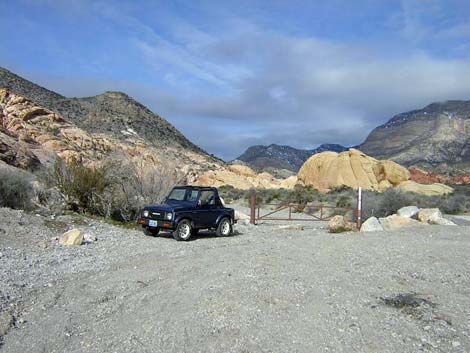 Original Brownstone Trailhead (view NW) |
NOTICE: The expansion of Summerlin to the eastern edge of Red Rock Canyon NCA has blocked the access road. There are ways to get to the trailhead, but I don't think they are legal, and I don't know if access will ever be permitted. Hikers can access this area from Calico Basin (longer) and Sandstone Quarry (shorter). Overview The 4.5-mile access road requires a 4WD vehicle, which limits access, but this route makes for a nice hike into the La Madre Mountain Wilderness Area. The access road and the hiking route run up a broad wash in a desert valley with sandstone and limestone mountains all around. From the trailhead, the route passes a side canyon with an old cement dam (a cattle tank), passes some rock art and a few agave-roasting pits, and runs out for 1.3 miles to another tank. The second tank is a bit unusual because it was built across the mouth of a broad sandstone basin rather than a narrow canyon. The valley is well-vegetated with a diverse assemblage of plant species, and there is some nice rock art on the canyon walls. Link to map. |
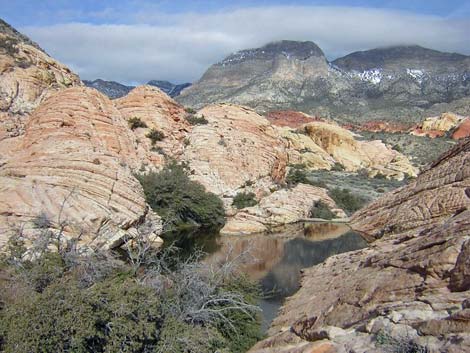 Lower Brownstone Tank (view NE) |
Watch Out Other than the standard warnings about hiking in the desert, ...this hike is safe if you stay in the wash and don’t climb the 4th-class cliffs to get a closer look at the rock art. While hiking, please respect the land and the other people out there, and try to Leave No Trace of your passage. Also, even though this is a short hike, be sure to bring what you need of the 10 Essentials. |
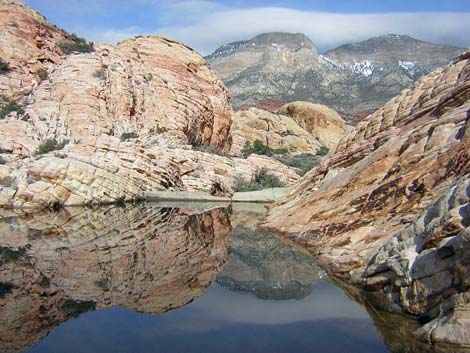 Lower Brownstone Tank (view NE) |
Getting to the Trailhead
This hike is located in Red Rock Canyon National Conservation Area, about 20 minutes west of Las Vegas, but not on the Scenic Loop Road. The trailhead is located off Charleston Blvd (Highway 159), just past the housing developments. The 4.5-mile access road requires a 4WD vehicle and takes about 50 minutes. This is not in the fee area. From town, drive out towards Red Rocks. From West Charleston Blvd at the Highway I-215 beltway (Table 1, Site 516), continue west on Charleston for about 1-1/2 miles. Past the edge of the housing developments (Site XX1), turn right into the desert on an unmarked 2-track road. Vehicles with 2WD should stop here. |
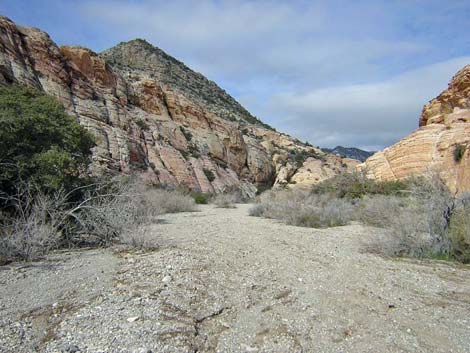 Sandstone cliffs and Turtlehead peak (view NW) |
From the edge of the pavement, drive north across the broad wash and up a side wash to a powerline road. Turn left onto the powerline road and drive west across a wash. Continue west for about 3/4 miles. The road crosses two more major washes, both of which could require 4WD to get back out, before arriving at Brownstone Wash (Site XX2). At Brownstone Wash, turn right into the gravel wash and drive up the canyon (northwest) for about 3.5 miles to a large, metal gate (Site XX3). Park here, this is the trailhead. Note that the sand and gravel get softer and deeper the farther up the wash you drive, and while you might be able to drive all the way in a 2WD vehicle, backing out of the sandy little dead-ends near the end of the road could be a problem. |
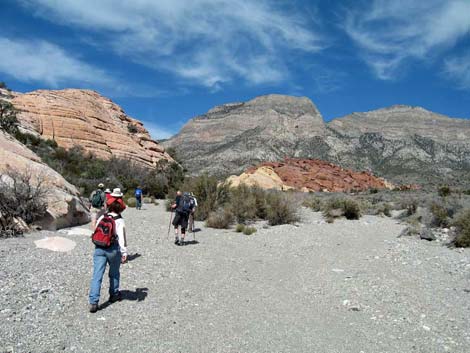 |
The Hike From the trailhead (Table 1, Waypoint 01), the route passes the gate and runs up the wash. At this point, Brownstone Canyon is a wide, flat valley with red and white sandstone outcrops to the west and up the canyon, and gray limestone cliffs and mountains to the north and east. Looking back down the canyon, you can see Las Vegas in the distance. The vegetation is fairly lush and diverse for this part of the desert, reflecting the diversity of the Pinyon-Juniper Woodland zone and the water in the wash. There is lots of shrub live oak, desert willow, desert almond, silk tassel, apache plume, cliffrose, narrow-leaved yerba santa, paperbag bush, and redbud in and along the wash, and even a few velvet ash trees. Beyond the edge of the wash, there are a few Utah juniper trees, plus lots of blackbrush, Mojave yucca, manzanita, and Mormon tea. Farther up the wash, singleleaf pinyon pines become common. |
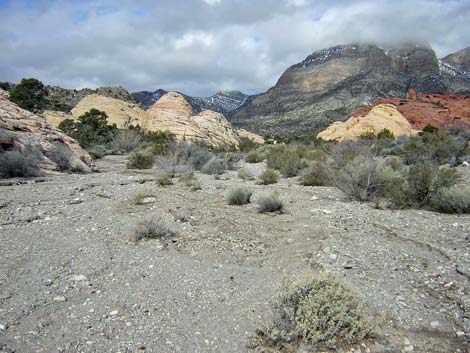 Nearing the end of sandstone (view NW) |
About 0.22 miles up the wash (Wpt. 02), an old road cuts up the left bank and out of the wash, heading into the rocks. The road leads a short distance to an old, 10-foot-high cement dam (Wpt. 07) that blocks a narrow gorge in the sandstone and holds back rainwater. Cattlemen built the dam to supply water for livestock, but it also supplies water for other desert creatures; watch for bighorn sheep scat in the area. This dam was constructed in the usual way by pouring concrete between wooden frames. The cattlemen who built it call the dam and the pond a "cattle tank," or simply a "tank." Natural potholes in the rocks are sometimes called tanks, and Calico Tank is an unusually large example of a natural tank. |
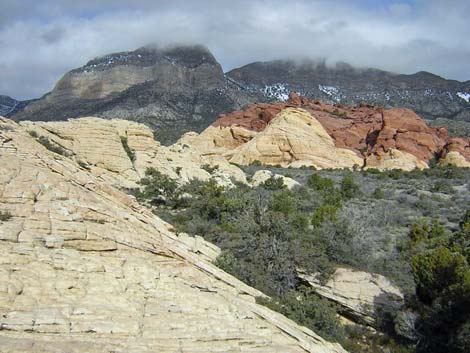 |
During wet years, the dam holds back a fairly large pool of water. Shrub live oaks grow around the pond, but there are no trees or anything to indicate that it often holds water. However, below the dam, the few velvet ash trees suggest that this gully is a good place for plants to get water. When hiking back to the main wash, notice the petroglyphs on the cliff (facing the main wash) above the old road and the agave-roasting pit (Wpt. 08) across the wash; look for a sign about ancient kitchens on the north side of the wash. Continuing up the wash, there are more nice petroglyphs high on the cliffs overlooking the wash (Wpt. 03). I climbed the 4th-class cliffs to get a better look, but after my efforts, I was a bit disappointed because the view from the wash with binoculars was better than the close-up view. I think this is because when you are up on the cliff, you are too close, and you can’t step back far enough to take in the entire scene. |
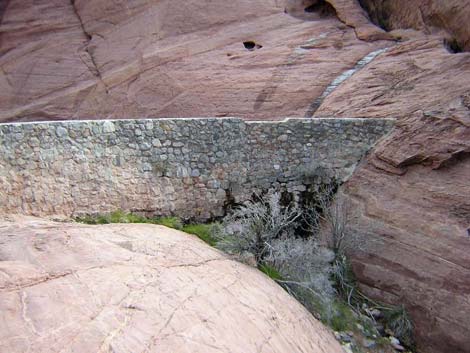 Upper Brownstone Tank (view southeast) |
Continuing up the wash, the route passes between sandstone outcrops and the canyon opens up a bit. In places and you can see Turtlehead Peak off to the southwest, and you can see one more big outcrop of red and white sandstone ahead to the northwest. There are at least two more agave-roasting pits along this part of the wash (Wpts. 09 and 10), and the pinyons and junipers become more common through here too. As the wash starts to pass the last sandstone outcrop on the right (to the north), an old road leaves the wash (Wpt. 04), turns more to the north, and runs along the west side of the sandstone outcrop. Initially, the old road looks like a wash, but it becomes obvious after a few yards. About 0.11 miles up the old road, the road forks (Wpt. 05). The left fork leads west towards the crest of the ridge north of Turtlehead Peak. |
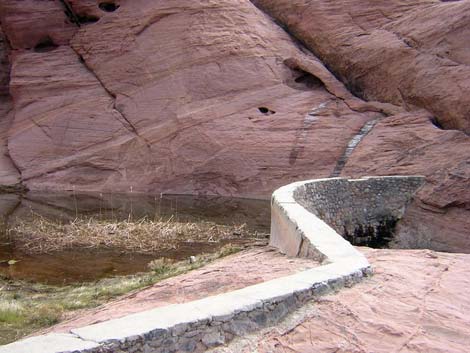 Upper Brownstone Tank (view south) |
The fork to the right leads north to the other tank, which is about 0.15 miles from the fork. This tank (Wpt. 06) was constructed in a broad alcove in the sandstone, which is unusual because they had to construct a long, low dam across a flat area to capture the water. This tank is also interesting because they built the dam by cementing stones together and cementing over the exterior to provide a smooth finish. Most tanks in the area were constructed by pouring concrete between wooden frames. They put a metal pipe through the dam, which was used to run water down to a cement watering trough in the wash below the dam. The dam must be fairly effective in holding back water because it supports a stand of cattails and two trees (possibly cottonwood trees), and there is a bit of sheep scat around. The sandstone alcove above the tank is a nice place to sit quietly, listen to the sounds of the desert, eat lunch, and contemplate the lives of the Indians and cowboys who lived in this land long ago. When refreshed, follow your footprints back down the wash to the trailhead. |
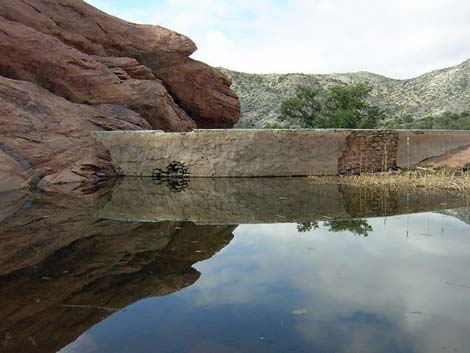 Upper Brownstone Tank (view SW) |
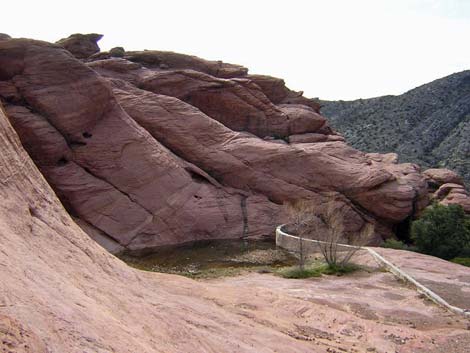 Upper Brownstone Tank (view S) |
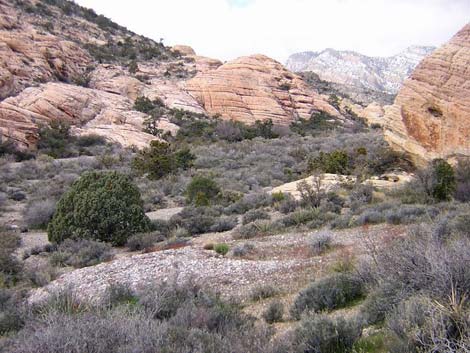 Agave-roasting pit along the wash (view NW) |
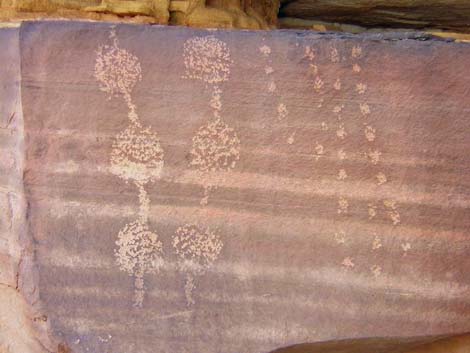 Rock stories on sandstone |
Table 1. Hiking Coordinates Based on GPS Data (NAD27; UTM Zone 11S). Download Hiking GPS Waypoints (*.gpx) file.
| Wpt. | Location | UTM Easting | UTM Northing | Elevation (ft) | Point-to-Point Distance (mi) | Cumulative Distance (mi) |
|---|---|---|---|---|---|---|
| 01 | Trailhead | 641437 | 4005324 | 4,749 | 0.00 | 0.00 |
| 02 | Road to Lower Dam | 641124 | 4005328 | 4,835 | 0.21 | 0.21 |
| 03 | Petro High on Wall | 640871 | 4005371 | 4,877 | 0.16 | 0.37 |
| 04 | Road Leaves Wash | 640015 | 4005899 | 5,182 | 0.66 | 1.03 |
| 05 | Fork in Old Road | 639912 | 4006036 | 5,227 | 0.11 | 1.14 |
| 06 | Upper Dam | 639983 | 4006190 | 5,268 | 0.15 | 1.29 |
| 07 | Lower Dam | 641170 | 4005260 | 4,839 | . | . |
| 08 | Agave Roasting Pit | 641154 | 4005381 | 4,849 | . | . |
| 09 | Agave Roasting Pit | 640801 | 4005537 | 4,995 | . | . |
| 10 | Agave Roasting Pit | 640368 | 4005716 | 5,064 | . | . |
| 01 | Trailhead | 641437 | 4005324 | 4,749 | 1.29 | 2.58 |
Happy Hiking! All distances, elevations, and other facts are approximate.
![]() ; Last updated 240329
; Last updated 240329
| Hiking Around Red Rocks | Hiking Around Las Vegas | Glossary | Copyright, Conditions, Disclaimer | Home |